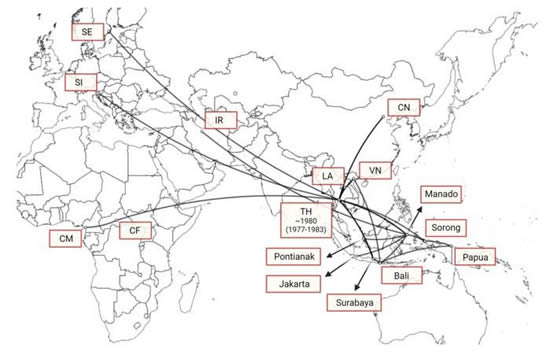NEWS RELEASE 10-MAY-2024
Tracing HIV in Indonesia
KOBE UNIVERSITY

CAPTION: According to the data of the Kobe University research team, the HIV substrain dominant in Southeast Asia was brought to Thailand around 1977, from where it started to spread through this part of the world. The virus was brought to Indonesia at least three different times, sometimes via different countries such as Vietnam and Laos. And while it was mostly Thai substrains that spread to other parts of the world, it was an Indonesian substrain that moved on to Iran.
CREDIT: S.Q. Khairunisa et al. Published by Springer Nature
The HIV variant dominant in Indonesia was introduced from Thailand over multiple events. The Kobe University study traces where it came from and how it spread from there, offering insights of possible value to the development of treatments against the disease.
HIV is the virus causing AIDS, but one of the things that make it so difficult to treat is that there are many variants of it. Kobe University virologist KAMEOKA Masanori says, “The diversity is increasing every day and the prevalent virus strains differ from region to region around the world.” Knowing which variants of the virus are prevalent in a given region and how it spreads from one to another is relevant not only to better trace the epidemic, but also to ensure that treatments are deployed against those variants that are most likely to occur in any given region.
In Indonesia, the fourth-most populous country on Earth, only a third of the affected have access to anti-HIV drugs, and little is known about the circulating strains. “Indonesia is recognized as one of the countries where the HIV/AIDS pandemic is still expanding. Kobe University has established a joint research center for infectious diseases at the Institute of Tropical Diseases at the Universitas Airlangga, Indonesia, and so we decided to decode the viral genome from blood samples of individuals infected with HIV-1 (out of the two main HIV types, the one causing the vast majority of AIDS cases worldwide) around the country to clarify the viral transmission trends,” explains Kameoka.
Their findings, now published in the journal Scientific Reports, show that all of the analyzed viruses belonged to a strain called “CRF01_AE” first identified in Thailand. But their detailed analysis shows that from there, the virus was brought to Indonesia at least three different times, sometimes via different countries such as Vietnam and Laos. And while it was Thai substrains that spread to most of Southeast Asia and also to other parts of the world, it was an Indonesian substrain that moved on to Iran. In the paper, the researchers write, “As a country with a high incidence of HIV-1 infection in Southeast Asia, Indonesia may contribute to the spread of HIV to other Asian countries.”
With their data, the Kobe University research team could trace the timeline of the spread of the CRF01_AE strain. Having originally emerged in Africa, it probably was brought to Thailand around 1977, from where it started to spread through Southeast Asia. It probably first entered Indonesia around 1980, then again via Laos around 1983 and via Vietnam around 1985. Only then, in 1985, it was recorded for the first time, in Thailand, and according to the WHO has been the dominant strain of HIV in Southeast Asia since 1990 and has become the dominant strain in East Asia, including also China and Japan, in the last decade.
Kameoka explains the importance of pursuing this line of research: “I personally believe that it is important to constantly monitor and accumulate information on viral genome genetic information in endemic areas, as viruses causing infectious diseases can change their properties due to genetic variation. Such information could also be useful for control and countermeasures against infectious diseases by estimating epidemic routes and transmission trends.”
This research was funded by the Ministry of Education, Culture, Sport, Science and Technology Japan, the Japan Agency for Medical Research and Development, the Ministry of Education, Culture, Research, and Technology, Indonesia, and Universitas Airlangga (grant 571/UN3.15/PT/2021). It was conducted in collaboration with researchers from Universitas Airlangga and Ritsumeikan University.
Kobe University is a national university with roots dating back to the Kobe Commercial School founded in 1902. It is now one of Japan’s leading comprehensive research universities with nearly 16,000 students and nearly 1,700 faculty in 10 faculties and schools and 15 graduate schools. Combining the social and natural sciences to cultivate leaders with an interdisciplinary perspective, Kobe University creates knowledge and fosters innovation to address society’s challenges.
JOURNAL
Scientific Reports
ARTICLE TITLE
Spatial–temporal transmission dynamics of HIV-1 CRF01_AE in Indonesia
ARTICLE PUBLICATION DATE
10-May-2024
Contact:
Daniel Schenz PhD
International Public Relations Officer
Kobe University
daniel.schenz@people.kobe-u.ac.jp
+81-78-803-5160
https://www.kobe-u.ac.jp/en
Source: https://www.eurekalert.org/multimedia/1025172
"Reproduced with permission - KOBE UNIVERSITY"
KOBE UNIVERSITY
For more HIV and AIDS News visit...
Positively Positive - Living with HIV/AIDS:
HIV/AIDS News
|